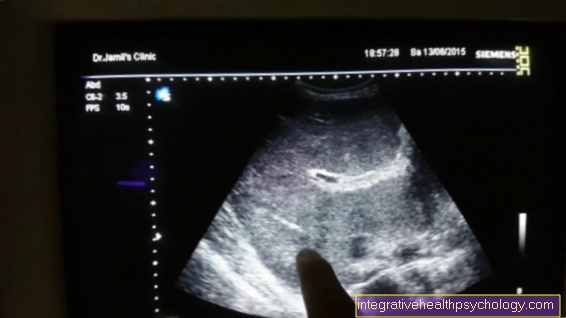The Asian tiger mosquito
definition
The Asian tiger mosquito is a subspecies of mosquitoes that is native to tropical climates. The Asian tiger mosquito has also been found in Europe since the middle of the 20th century.
It is known to transmit various pathogens. This transmission plays a role not only in humans but also in animals.
The diseases transmitted to humans include dengue fever and chikungunya fever. A role of the Asian tiger mosquito in the spread of the Zika virus is also discussed.

Where does the Asian tiger mosquito occur in Germany?
The Asian tiger mosquito is not originally native to Germany. It usually lives in warmer climates. With climate change, however, the weather in Germany changes in such a way that the Asian tiger mosquito can also live here.
The mosquito is brought in almost exclusively by trucks and other vehicles from southern European countries. Therefore it can only be found along the major highways so far. Several Asian tiger mosquitoes or their larvae and eggs were found at various rest stops along the A5 in Baden-Württemberg. The mosquito was also discovered in Freiburg and some other Baden-Württemberg communities. In Bavaria, some of the animals were found in Nuremberg, others near Bamberg. The Asian tiger mosquito is now also spreading in Hesse.
However, it can generally be said that very few of the animals have made it to Germany so far. As before, only a few mosquitoes or their eggs are discovered. In addition, no pathogens were found in the mosquitoes examined in Germany.
Where does the Asian tiger mosquito occur in Switzerland?
The Asian tiger mosquito has probably penetrated Switzerland via Italy and can therefore be found mainly in the south of the country.
The canton of Ticino is particularly affected by the mosquito colonization. The canton is located in the very south of Switzerland, just north of Milan. Eggs, larvae or adult Asian tiger mosquitoes have already been found in around 60 of the canton's 115 municipalities.
Similar to Germany, the tiger mosquito was mainly brought into the country via the traffic routes.
In contrast to Italy, special measures are taken in Switzerland to prevent further spread of the mosquito species. This includes, for example, not creating standing water.
The uncontrolled spread of the tiger mosquito could be prevented by the strictly implemented measures.
In addition, no animals have so far been found in Switzerland that are actually infected with one of the dreaded diseases such as dengue fever or chikungunya fever.
Where does the Asian tiger mosquito occur in Italy?
The Asian tiger mosquito was not originally native to Italy either. However, their occurrence has been known in Italy since the 1990s. It is suspected that the mosquito was spread via transport routes from the USA.
In the meantime the tiger mosquito has spread over the entire Italian mainland. The south is particularly affected. Several animals of this type have also been found in Sicily and Sardinia.
The Asian tiger mosquito spreads particularly quickly in Italy because it has no natural predators there.
In addition, the government has not yet taken any specific containment measures that, for example, provide for a reduction in areas with standing water or the widespread use of insect repellants.
In Italy, colonization by the Asian tiger mosquito is more threatening than, for example, in Switzerland or Germany, since animals have already been found there that are infected with pathogens. As a result, they can transmit (life) dangerous diseases such as dengue or chikungunya fever.
Asian tiger mosquito bite
What does the bite of the Asian tiger mosquito look like?
The bite of the Asian tiger mosquito initially looks like a classic mosquito bite. Usually a slight swelling is visible at the beginning, and a wheal can also form at the puncture site.
Local skin reactions occur due to the body's reaction to the saliva applied by the mosquito. These are accompanied by a more pronounced swelling. In addition, the area will redden and may become warm or hot.
Pain may also occur with the inflammation.
Everyone reacts differently to an insect bite. Depending on how the body reacts, the swelling can be limited to the puncture site or spread to an area the size of a hand.
In addition, the extent of the reaction depends on whether the tiger mosquito was infected with a pathogen. The tendency is that the stronger the infection, the stronger the body's reaction to the bite.
But also the bite of a black fly or the Asian bush mosquito look similar.
Read more on the subject at: Insect bite
Symptoms of a sting
The bite of the Asian tiger mosquito is significantly more painful compared to the mosquito generally known in Germany. There is swelling at the puncture site. In addition, there can be an inflammatory reaction there, which is expressed by reddening and overheating of the affected area.
The bite becomes problematic when the Asian tiger mosquito has previously been infected with a pathogen. She can take this from the person she stung before and then pass it on to her next victim.
Typically, dengue fever or chikungunya fever is transmitted by the mosquito.
Both diseases are expressed in a particularly high fever. You will also experience muscle pain, headaches, joint problems and possibly a rash.
In rare cases, the pathogen can also establish itself in individual organs. These are mostly the liver, the heart or the meninges. In most cases, the infection of the organs leads to damage that often cannot be reversed. However, organ involvement is a rare complication.
They find out, which symptoms you can use to recognize the bite of the Asian tiger mosquito.
swelling
As with a classic mosquito bite, swelling in the affected area can occur after being bitten by the Asian tiger mosquito.
The swelling is usually due to the body reacting to components of the mosquito saliva. This saliva is brought into the human body by the tiger mosquito when it bites, as it acts as a blood thinner and thus the mosquito can suck blood more easily.
Typically, the reaction to a bite by the Asian tiger mosquito is stronger than to a common mosquito bite, so that there is also greater swelling.
If the puncture site is infected, the swelling increases and the affected area becomes painful, reddened and heated.
How long do the symptoms last?
As after being bitten by a “normal” native mosquito, the symptoms of an Asian tiger mosquito bite can last for a few days.
How long the itch persists depends primarily on whether the bite is scratched or not. Pain, swelling and signs of inflammation also subside more quickly if the puncture site is not scratched open.
In addition, the duration of the symptoms is determined by whether the mosquito has had enough time to fully inject its salivary secretions.
In addition, the strength of the body's own defense reaction is crucial.
In general, symptoms shouldn't last more than a week. Of course, it can take longer if the sting causes infection.
Read more about this at: Inflammation after a mosquito bite
Inflammation after a sting
The bite of an Asian tiger mosquito can get infected like any other mosquito bite. Since the mosquito injects salivary secretions when biting, which thins the blood, the body reacts to defense. Depending on how strongly the body reacts and how much secretion has been injected, the reaction lasts longer or shorter. Many people also have an allergic reaction to the bite.
An inflammation usually develops when the mosquito was previously infected with a pathogen.
The inflammation manifests itself as pain, swelling, reddening of the affected area. Small local inflammatory reactions can usually be relieved by cooling. If the inflammation increases or spreads, a doctor should be seen.
Read more on the subject at: Inflamed insect bite - when is it dangerous?
forecast
The prognosis after a bite by the Asian tiger mosquito depends heavily on whether complications arise and whether the bite infects you with a disease. The sting itself is harmless and usually goes away after a while without leaving any damage.
If you are infected with dengue or chikungunya fever, the prognosis depends on the course of the disease. Both viruses can cause severe symptoms that go away in a few weeks to months. In vulnerable groups of people (children, old people, immunocompromised) the disease can also be fatal.
What to do if I was stung
The bite of the Asian tiger mosquito itself is harmless, but it is accompanied by pain, swelling and possibly inflammation. With such symptoms, it is usually sufficient to cool the affected area and possibly treat it with creams such as Fenistil®.
The increasingly fashionable after-bite pens can help relieve the itching because the mosquito bite should not be scratched under any circumstances. This increases the risk of infection with germs from the environment.
It becomes dangerous if the mosquito bite or even the part of the body (arm / hand / foot etc.) swells beyond the normal level or if more pain is felt. In these cases, a doctor should be consulted, and in emergencies, a hospital with an emergency room should be consulted directly.
Even if symptoms such as fever, headache, pain in the limbs or the like occur a few days after the bite, a doctor should be visited immediately. This should test for various possible viruses and other infections in order to be able to treat a disease as quickly as possible.
Protection against the Asian tiger mosquito
In order to protect yourself from the Asian tiger mosquito, measures similar to those used for classic insect protection are suitable.
Mosquito nets on windows and doors prevent the mosquitoes from entering residential buildings. Anti-mosquito spray on the skin and clothing also keeps the animals away.
You should be particularly careful in the twilight phase, as mosquitoes are mainly on the move at this time. However, the Asian tiger mosquito is both diurnal and nocturnal, so that there is no absolute protection at any time of the day.
Especially when it is dark, lights should only be switched on in the room when the windows are closed or they are protected by mosquito nets. If you want to protect yourself from a sting outside, you are advised not to use insect repellent but also to wear long clothing.
It is also advisable to avoid areas with standing water, such as swamps and lakes. Insects can lay their eggs there, so there are a particularly large number of animals in these areas.
Read more on this topic at: Mosquito repellent
Asian tiger mosquito bite during pregnancy - is it dangerous?
A dengue or chikungunya infection during pregnancy is initially no more dangerous for the pregnant woman than it is for other people. However, the unborn child can also develop the infection and suffer consequential damage.
In addition, the risk of a miscarriage is slightly higher if the woman becomes infected with one of the viruses during pregnancy.
The Zika virus, on the other hand, is much more dangerous. It is known that a Zika infection during pregnancy can lead to severe malformations and disabilities. For example, there is an increased risk that the child will Microcephaly (head that is too small) suffers and thus carries a mental handicap.
Complications
In most cases, the complications of a bite by the Asian tiger mosquito only arise if the animal was previously infected with a pathogen. This mainly affects the Dengue or Chikungunya virus, which mainly occurs in tropical climates.
The spread of the Zika virus by the Asian tiger mosquito is currently still being discussed.
Dengue fever usually develops two to seven days after the bite and manifests itself in flu-like symptoms. Fever and chills develop, as well as pain in the limbs, joints and headaches.About five days later, lymph node swelling and an exanthem (large skin rash) appear.
Read more about this at: Symptoms of Degue Fever
Chikungunya fever is also manifested by fever and chills. Particularly in the foreground of this disease are the severe joint pains, which lead to a stooped gait and which gave the disease its name (Chikungunya = stooped). If the illnesses are treated with sufficient fluid intake and possibly antipyretic and pain relieving agents, they will disappear again after a few days to weeks. However, in vulnerable groups of people (children, old people, immunocompromised) the disease can be much worse and even be fatal.
That could be interesting for you too: Asian (Japanese) bush mosquito
After every insect bite there is a risk of developing an allergic reaction. First of all, nausea and dizziness occur, but these can also develop into poor circulation and shortness of breath or even shock.
Read more under. Allergic reaction to a mosquito bite
Is there a vaccination?
The two diseases most commonly transmitted by the Asian tiger mosquito are dengue fever and chikungunya fever.
The first vaccines against dengue were approved in 2015, but these are mainly available in the affected regions such as Asia and South America. A 2016 study showed that the vaccine protected 100% of those vaccinated against dengue fever and the related Zika virus. In Germany, the vaccine should be on the market by 2019.
No vaccine is currently available against Chikungunya fever. A vaccination consisting of individual parts of the Chikungunya virus is currently being tested and is showing great promise in the first studies.
The Asian tiger mosquito and the Zika virus
A possible transmission of the Zika virus by the Asian tiger mosquito is suspected. The symptoms are similar to those of ordinary flu. There is a fever and muscle and headache as well as joint problems. Conjunctivitis can also occur. The symptoms last for about two to seven days.
Compared to other diseases transmitted by the Asian tiger mosquito, an infection with the Zika virus is rather mild. The disease can usually be cured by bed rest and plenty of fluid intake.
It can be dangerous if the Zika infection triggers the Guillain-Barré syndrome. This manifests itself in limb and back pain and can lead to symmetrical paralysis of the pelvic, trunk and respiratory muscles. The symptoms are based on an attack on the nervous system and can have serious to life-threatening consequences.
Furthermore, a Zika infection during pregnancy can cause serious harm to the child.
Read more on the subject at: Zika virus





























